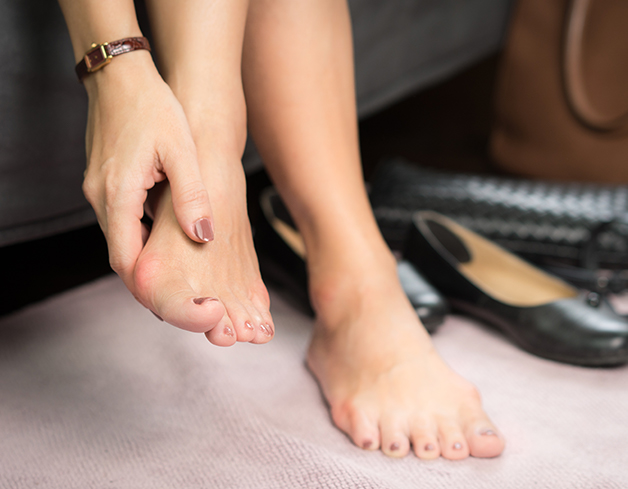

What are they?
A Bunion is a deformity of the joint at the base of the big toe. It is the most common deformity in the front of the foot. The condition occurs when the big toe moves and points towards the second toe, forcing the first metatarsal and the connecting joint to protrude outwards. This results in the metatarsal head becoming prominent and inflamed. The bursa (a fluid-filled sac) surrounding the joint becomes swollen, causing stiffness and pain.

Medically known as Hallux Valgus, the condition affects 23% of adults between the ages of 18 to 65 years of age and the incidence increases to 35%, in adults over the age of 65. The condition is more frequent in women.
Bunions are painful. The friction and pressure on the soft tissue, skin and bursa of the metatarsal joint can cause extreme discomfort. As the condition worsens, the deformity of the foot can cause a slight dislocation of the joint (subluxation). The joint will then move unnaturally causing further accelerated deterioration. These changes in the biomechanics (movement) of the joint and foot can also result in the patient having difficulty in controlling their balance. These symptoms can decrease the activity levels and quality of life in people with Bunions.
What causes it?
The causes for the condition are currently largely unknown. However, some potential causes are discussed below.
As stated previously, Bunions are more common in women than men. This deformity is also associated with the narrow shoes that women tend to wear. Footwear, with high-heels and heeled boots often have pointed toe-boxes. These compress the toes together, forcing the big toe to point towards the other toes. This is considered to be one of the mechanisms by which the deformity develops. It is therefore widely believed that poor footwear is a significant, external contributing factor that triggers bunion formation.
A second potential cause for the Hallux Valgus is suggested to be genetics. There is also an association between flat feet and Hallux Valgus. Posterior tibial tendon weakness, which can occur around the age of 50, causes flat feet. As the tendon becomes weak, the arch collapses and the toes are pushed out as a compensatory mechanism. Supporting the arch with an orthotic will prevent the collapse of the arch and thereby prevent formation of a Bunion.
How is it treated?
Non-operative treatment
Painful Bunions can be treated by applying ice and ensuring that the joint is well rested. Analgesics (pain killers) and anti-inflammatory drugs will also help in an acute episode.

Orthotics
Orthotics and splints help by correcting the alignment, reducing pain and alleviating pressure on the affected joint. By reducing the deformity, it increases mobility and prevents stiffness from developing in the joint. The increased mobility also delays progression of the deformity. Some Bunion cushions have gel or fleece padding, which protects the foot and reduces the amount the Bunion rubs on shoes. The results from wearing these cushions can be positive by making daily activities, such as walking, easier.
A study by Nakagawa and colleagues found that wearing total contact orthotics decreased pain and improved patient satisfaction with Hallux Valgus for at least 12 months. Another independent study conducted by Budiman-Mak and colleagues in patients with Rheumatoid Arthritis revealed that using orthoses decreased the possibility of developing Hallux Valgus by 73% .

Operative treatment
Surgery may be needed if permanent deformity has to be corrected. There are many forms of surgery which can be carried out to help with Bunions. Depending on the severity of the condition one or a combination of the following operations are carried out:
- Osteotomy – This is the most commonly performed surgical procedure to correct a Bunion. It involves the removal of the abnormal bony lump, cutting the bone (metatarsal) and realignment of the cut ends to allow the toe to point forward.
- Arthrodesis / Fusion – In this procedure, the ends of the bones are shaved and the joint is removed. The ends of the bones are then held together with screws and plates. This can be done at the tarsometatarsal joint (near the midfoot) or at the metatarsophalangeal joint (near the ball of the foot). This procedure is reserved for patients with extreme deformities.
- Excision (Keller’s) Arthroplasty – This involves removal of both the bunion and the toe joint. A false fibrous joint is then allowed to develop slowly over time. This surgery is not commonly performed and limited for patients with very low demand.
- Surgery may not also provide the benefits expected. Success rates are usually 80-90% but complications and failure rates can be as high as 20-30%. You may also not be able to wear all your shoes following surgery. Robinson and colleagues identified that only 62% of patients undergoing surgery could return to wearing heeled footwear.
more recommended stories
 Ultramarathon Physiology: What HCPs Should Know?
Ultramarathon Physiology: What HCPs Should Know?Ultramarathon Metabolism: What Happens to the.
 High-Intensity Training and Oxidative Stress Insights
High-Intensity Training and Oxidative Stress InsightsNew Evidence Linking High-Intensity Training and.
 Sterilized Fermented Beverage for Obesity: New Evidence
Sterilized Fermented Beverage for Obesity: New EvidenceEarly Insights Into a Sterilized Fermented.
 Cardiovascular Risk and Sudden Cardiac Death in Diabetes
Cardiovascular Risk and Sudden Cardiac Death in DiabetesRising Sudden Cardiac Death (SCD) Risk.
 Perinatal Mental Health Challenges Highlighted in New Study
Perinatal Mental Health Challenges Highlighted in New StudyMental Health Challenges in New Parents:.
 Walking Speed Before Hip Replacement Predicts Recovery
Walking Speed Before Hip Replacement Predicts RecoveryNew Evidence Points to a Simple,.
 How Soybean Oil Impacts Weight Gain and Metabolism
How Soybean Oil Impacts Weight Gain and MetabolismWhy Soybean Oil May Affect Metabolism.
 New Malaria Prevention Insights From African Biostatistics
New Malaria Prevention Insights From African BiostatisticsHow New Data Is Reframing Malaria.
 World Summit Outlines Core Principles for Healthy Longevity
World Summit Outlines Core Principles for Healthy LongevityWhy Healthy Longevity Demands a New.
 Gut Immune Cells and Long-Lasting Antiviral Protection.
Gut Immune Cells and Long-Lasting Antiviral Protection.Breakthrough Findings on How Gut Immune.

Leave a Comment